 Image search results - "biwa-cho" Image search results - "biwa-cho" |

Inside the Haiden Hall, you can buy these little dishes. Buy two of them. You write your name on one and your wish on the other dish. Then throw it through the torii gate.
|
|
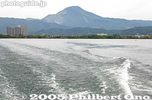
View of Mt. Ibuki as we leave Nagahama Port. Map for Nagahama PortChikubushima can be reached from Nagahama Port, Hikone Port, or Imazu Port on the other side of the lake. There are several round trips every day from either port. Nagahama boat schedule and Hikone boat schedule
|
|
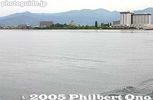
Nagahama from Lake Biwa
|
|

Nagahama Castle from Lake Biwa
|
|

Mt. Ibuki from Lake Biwa
|
|
|

Chikubushima in the distance
|
|
|
|
|

Heading for Chikubushima.
|
|

Approaching Chikubushima.
|
|
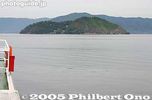
Chikubushima
|
|

Chikubushima used to be a lush green island. Now it is turning brown by the thousands of cormorants which nest on the island, beyond the reach of humans.
|
|

Chikubushima is home to Hogonji Temple first built in 724 as ordered by the Emperor to worship the Goddess Benzaiten. It belongs to the Shingon Buddhist Sect (Buzan School) and it is the 30th temple in the 33-Temple Pilgrimage of Saigoku. 宝厳寺
|
|

Chikubushima is also home to Tsukubusuma (Chikubushima) Shrine which is also a National Treasure. Until 1868 when Buddhist temples and Shinto shrines were required to be separate, the shrine was part of Hogonji temple.
|
|

Whenever you see a torii gate, it indicates the grounds of Tsukubusuma Shrine. The shrine is actually integrated with Hogonji temple.
|
|

Boat landing 宝厳寺
|
|
|
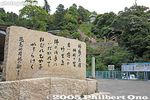
Lake Biwa Rowing Song (Biwako Shuko no Uta) monument. One of the verses mentions Chikubushima. This monument commemorates the song and that verse. 琵琶湖就航の歌 歌碑
|
|
|
|
|
|
|
|
|
|

Torii gate and bridge to Tsukubusuma Shrine, also called Chikubushima Shrine.
|
|
|

Tsukubusuma Shrine's Haiden Hall
|
|
|
|

The snake is a messenger of the Goddess Benzaiten.
|
|

Throw your two dishes at the torii gate. If your dish goes under the torii gate, your wish will come true. Geez, look at all those failed wishes (shattered dishes).This is also one location where the film Idai Naru, Shurararabon (偉大なる、しゅららぼん The Great Shu Ra Ra Boom) was filmed. The scene where Ryosuke throws his small dish through the torii.
|
|
|

View of Nagahama from Chikubushima
|
|
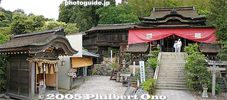
Tsukubusuma Shrine (National Treasure) on Chikubushima island, Nagahama, Shiga. It worships Benzaiten as well as the Dragon God and Azai-hime. 都久夫須麻神社
|
|

Tsukubusuma Shrine (National Treasure)
|
|

Tsukubusuma Shrine (National Treasure)
|
|

Funa-roka boat corridor connects Tsukubusuma Shrine and the Kannon-do Hall. Important Cultural Property. From the Momoyama Period. 船廊下
|
|

Funa-roka boat corridor
|
|

Funa-roka boat corridor
|
|
|

Kannondo Temple
|
|
|

Kannondo Temple 観音堂
|
|

Kannondo Temple
|
|

Kannondo Temple
|
|

Kannondo Temple
|
|

Kannondo Temple
|
|

Very old and worn statue of Pindola Bharadvaja (賓頭盧尊者) inide Karamon Gate.
|
|

Very old and worn statue of Pindola Bharadvaja (賓頭盧尊者) inide Karamon Gate.
|
|

Very old and worn statue of Pindola Bharadvaja (賓頭盧尊者) inide Karamon Gate.
|
|
|

Chikubushima Port.
|
|
|
|
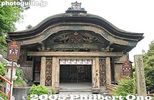
Karamon Gate 唐門 (National Treasure). Entrance to the Kannondo Temple. It might have come from Toyotomi Hideyoshi's original mausoleum in Kyoto. From the Momoyama Period. Chikubushima, Nagahama, Shiga.This could also have been the gate to the Gokuraku Bridge at Hideyoshi's Osaka Castle in the early 17th century.
|
|

Kannondo Temple and Karamon gate of Hogonji temple on Chikubushima island, Nagahama, Shiga.
|
|
|

Benzaiten-do Hall, the main worship hall of Hogonji temple.
|
|

Inside Benzai Tendo.
|
|

Inside Benzaiten-do Hall which houses one of Japan's three major statues of the Goddess Benzaiten.
|
|

Inside Benzai Tendo
|
|

Inside Benzai Tendo
|
|

Inside Benzai Tendo. The statue of Benzaiten in that corner was donated by the father of Lord Azai Nagamasa.
|
|

Inside Benzai Tendo
|
|

Benzai Tendo
|
|

Three-Story Pagoda. Reconstructed in 2000.
|
|
|
|
|
|
|

Chikubushima has some steep steps.
|
|
|
|
|
|
|

Interlaken boat to Imazu at Chikubushima.
|
|

Chikubushima
|
|
|
|

West view of Chikubushima
|
|
|
|
|
|